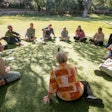The ASAE Great Ideas Conference 2015 in Orlando (March 8-11, 2015) brought about 800 association leaders, planners, consultants and association management companies together at Hyatt Regency Orlando. Connect Editor Stephanie Davis Smith dipped in and out of sessions chronicling trends, scribbling down strategies and quoting whip-smart speakers whose business advice crossed many different industries. Here are her three big takeaways from the experience:
1. The chapter model is dying.
Abe Eshkenazi, CEO of APICS, an association for supply chain and operations management, led a session on relationship-driven leadership. “The chapter model is not meeting the needs of the members anymore,” he said, causing much of the audience to get up and sneak out... although, they would have been wise to stay. In 2006, APICS had 280 chapters. They’re now down to 200. This trend in associations was echoed around the Hyatt’s pool during the opening reception, so I’m not sure why it was rebuffed in an education session with practical advice on how to reverse it. Eshkenazi urged association leaders who did stay to move from a product-delivery model to relationship model or risk losing members, making for smaller conferences and meetings in the future.
He and moderator, Anna Caraveli, managing partner at The Demand Networks, went on to describe how chapters act as independents and not as a network that shares ideas. “Young people come to a meeting and don’t see anyone who looks like them or is addressing their needs, and don’t return,” added Eshkenazi.
2. Talk to strangers.
The key to great conferences is meeting people you don’t know. That was Alan Gregerman’s opening general session talk, “The Necessity of Strangers.” Through allegory and funny props, Gregerman pushed the idea that “it’s not who we know, but who we could know” that would help grow associations and keep attendees coming back year after year. Like Eshkenazi, he urged the audience to hire people outside their industry to leadership positions to bring new ideas to the association and its members. He inspired us to look around: “We’re surrounded by geniuses” who can help us grow our associations and implement better meetings, he says. “We just have to take notice.” He used an example of an epic fail by the U.S. Census Bureau that could have been thwarted by UPS to illustrate the point.
3. Use a design-thinking approach to meetings.
Carol Hamilton of NAFSA: Association of International Educators and Geof Hammond of Allison Partners teamed up to present an innovative way of creating programs for association members. Instead of wasting money on a new idea, draw it out and test it with individuals in your association. “Diversify your portfolio of processes,” the duo advised, “so your failure won’t be so big.”
Why put all your eggs in one basket? “Most people just try something new and hope it works,” says Hammond. Instead, they advise planners to be more strategic and ideate multiple new concepts at once (a new seating arrangement, session format, app, etc.) and test those concepts with members before you ever apply them. Testing and testing and testing again before implementation “avoids large and costly launches of unproven ideas,” they said.
3 Key Takeaways from the ASAE Great Ideas Conference 2015
Latest in Meetings















